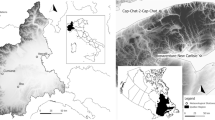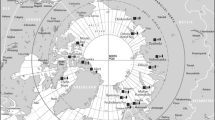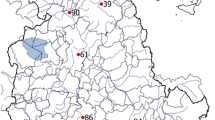Abstract
Having a high-quality database is a necessary condition to study the climate variations in a location, in a nation or in a continent. The World Meteorological Organization, WMO, is aware of the importance of identifying the non-climate factors that can modify the recorded values of the meteorological variables. According to this, WMO wrote a set of guidelines recognizing the need for National Meteorological Services to improve databases managing this kind of information (WMO 2007). One of these guidelines points out that this work can be done using parallel observations. Comparing series of Temperature, CoTemp, is a free and open source software written in R language that could help the identification of discontinuity caused by non-climate factors, change in instrumentation, change in positioning or change in the network. It works on parallel series with an overlapping period of at least 1 year. CoTemp starts with a statistical analysis, classifies the events (in cold, mean and heat events), and then shows their differences. CoTemp is a cross-platform software, easily adaptable to different needs, that takes in input a single text file with daily information of two temperature series and outputs tables (in CSV format) and plots (as PDF images) that help in the interpretation of the data. CoTemp code has been tested and used on different temperature series in the Piedmont region (northwestern Italy) and in the Gaspè Peninsula (Canada).



Similar content being viewed by others
References
Acquaotta F, Fratianni S, Venema V (2016) Assessment of parallel precipitation measurements networks in Piedmont, Italy. Int J Climatol 36(12):3963–3974. https://doi.org/10.1002/joc.4606
Acquaotta F, Fratianni S, Aguilar E, Fortin G (2019) Influence of instrumentation on long temperature time series. Clim Chang. https://doi.org/10.1007/s10584-019-02545-z
Adloff F, Gabriel Jordà G, Somot S, Sevault F, Arsouze T, Meyssignac B, Li L, Planton S (2018) Improving sea level simulation in Mediterranean regional climate models. Clim Dyn 51:1167–1178. https://doi.org/10.1007/s00382-017-3842-3
Fu YH, Zhao H, Piao S, Peaucelle M, Peng S, Zhou G, Ciais P, Huang M, Menzel A, Peñuelas J, Song Y, Vitasse Y, Zeng Z, Janssens I (2015) Declining global warming effects on the phenology of spring leaf unfolding. Nature 526:104–107. https://doi.org/10.1038/nature15402
Garzena D, Acquaotta F, Fratianni S (2018) Analysis of the Turin long time climatic series and assessment of the Urban Heat Island. Weather. https://doi.org/10.1002/wea.3292
Guenzi D, Acquaotta F, Garzena D, Fratianni S (2017a) CoRain: a free and open source software for rain series comparison. Earth Sci Inf 10(3):405–416. https://doi.org/10.1007/s12145-017-0301-y
Guenzi D, Fratianni S, Boraso R, Cremonini R (2017b) CondMerg: an open source implementation in R language of conditional merging for weather radars and rain gauges observations. Earth Sci Inf 10:127–135. https://doi.org/10.1007/s12145-016-0278-y
Hannart A, Mestre O, Naveau P (2014) An automated homogenization procedure via pairwise comparisons with application to Argentinean temperature series. Int J Climatol 34:3528–3545. https://doi.org/10.1002/joc.3925
Hubbard KG, Lin X (2006) Reexamination of instrument change effects in the US historical climatology network. Geophys Res Lett 33(15):1–4. https://doi.org/10.1029/2006GL027069
IPCC (Intergovernmental Panel on Climate Change) (2014) Impacts, adaptation, and vulnerability. Part a: global and sectoral aspects. Contribution of working group II to the fifth assessment report of the intergovernmental panel on climate change. Cambridge University Press, Cambridge, p 1132
Kendall MG (1975) Rank correlation methods. Griffin, London
Lejeune Q, Davin EL, Guillod BP, Seneviratne SI (2015) Influence of Amazonian deforestation on the future evolution of regional surface fluxes, circulation, surface temperature and precipitation. Clim Dyn 44(9–10):2769–2786. https://doi.org/10.1007/s00382-014-2203-8
Mann HB (1945) Nonparametric tests against trend. Econometrica 13:245–259
Mestre O, Gruber C, Prieur C, Caussinus H, Jourdain S (2011) SPLIDHOM: a method for homogenization of daily temperature observations. J Appl Meteorol Climatol 50:2343–2358. https://doi.org/10.1175/2011JAMC2641.1
Milewska EJ, Vincent LA (2016) Preserving continuity of long-term daily maximum and minimum temperature observations with automation of reference climate stations using overlapping data and meteorological conditions. Atmosphere-Ocean 54(1):32–47. https://doi.org/10.1080/07055900.2015.1135784
Pauli H, Gottfried M, Reiter K, Klettner C, Grabherr G (2007) Signals of range expansions and contractions of vascular plants in the high Alps: observations (1994–2004) at the GLORIA master site Schrankogel, Tyrol, Austria. Glob Chang Biol 13(1):147–156. https://doi.org/10.1111/j.1365-2486.2006.01282.x
R Development Core Team (2014) R: a language and environment for statistical computing. R Foundation for statistical computing, Vienna, Austria. https://www.r-project.org/. Accessed 16 Sept 2019
Ruffault J, Curt T, St-Paul NM, Moron V, Trigo R (2018) Extreme wildfire events are linked to global-change-type droughts in the northern Mediterranean. Nat Hazards Earth Syst Sci European Geosciences Union 18:847–856. https://doi.org/10.5194/nhess18-847-2018
Sen PK (1968) Estimates of the regression coefficient based on Kendall’s Tau. J Am Stat Assoc 63(324):1379–1389
Toreti A, Desiato F, Fioravanti G, Perconti W (2010) Seasonal temperatures over Italy and their relationship with low frequency atmospheric circulation patterns. Clim Chang 99(1–2):211–227. https://doi.org/10.1007/s10584-009-9640-0
Venema V, Mestre O, Aguilar E, Auer I, Guijarro JA, Domonkos P, Vertacnik G, Szentimrey T, Stepanek P, Zahradnicek P, Viarre J, Müller-Westermeier G, Lakatos M, Williams CN, Menne M, Lindau R, Rasol D, Rustemeier E, Kolokythas K, Marinova T, Andresen L, Acquaotta F, Fratianni S, Cheval S, Klancar M, Brunetti M, Gruber C, Prohom Duran M, Likso T, Esteban P, Brandsma T (2012) Benchmarking homogenization algorithms for monthly data. Clim Past 8:89–115. https://doi.org/10.5194/cp-8-89-2012
Vincent L, Milewska E, Wang X, Hartwell M (2018) Uncertainty in homogenized daily temperatures and derived indices of extremes illustrated using parallel observations in Canada. Int J Climatol 38:692–707. https://doi.org/10.1002/joc.5203
Willett K, Williams C, Jolliffe IT, Lund R, Alexander LV, Brönnimann S, Vincent LA, Easterbrook S, Venema VKC, Berry D, Warren RE, Lopardo G, Auchmann R, Aguilar E, Menne MJ, Gallagher C, Hausfather Z, Thorarinsdottir T, Thorne PW (2014) A framework for benchmarking of homogenisation algorithm performance on the global scale. Geosci Instrum Method Data Syst 3:187–200. https://doi.org/10.5194/gi-3-187-2014
WMO (2007) Guidelines for managing changes in climate observation programmes. World Meteorological Organization, World Climate Data and Monitoring Programme series, WCDMP-No. 62, WMO-TD No. 1378, Geneva, Switzerland
Yue S, Pilon P, Phinney B, Cavadias G (2002) The influence of autocorrelation on the ability to detect trend in hydrological series. Hydrol Process 16:1807–1829. https://doi.org/10.1002/hyp.1095
Author information
Authors and Affiliations
Corresponding author
Additional information
Communicated by: H. Babaie
Publisher’s note
Springer Nature remains neutral with regard to jurisdictional claims in published maps and institutional affiliations.
Supplementary material
Supplementary data and the program source code associated with this article can be found at https://github.com/UniToDSTGruppoClima/CoTemp
ESM 1
(TXT 113 kb)
ESM 2
(TXT 86.2 kb)
ESM 3
(TXT 69.6 kb)
Rights and permissions
About this article
Cite this article
Guenzi, D., Acquaotta, F., Garzena, D. et al. An algorithm for daily temperature comparison: Co.Temp - comparing series of temperature. Earth Sci Inform 13, 205–210 (2020). https://doi.org/10.1007/s12145-019-00414-y
Received:
Accepted:
Published:
Issue Date:
DOI: https://doi.org/10.1007/s12145-019-00414-y




